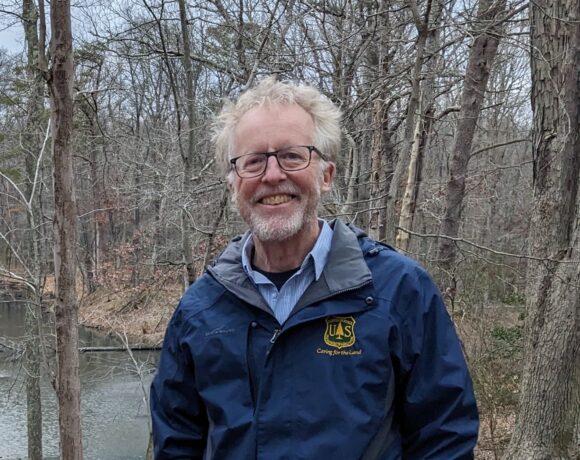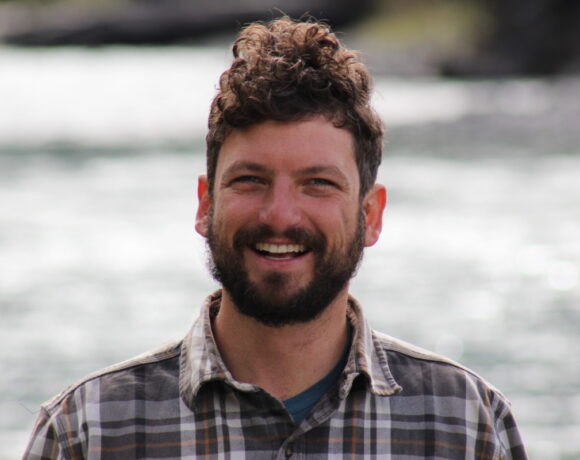Studying invasive insects outbreaks, biological control, and more, Dr. Dylan Parry of SUNY ESF strives to connect research to practice. NYISRI is pleased to feature his work in this month’s researcher spotlight:

What kinds of research questions related to invasive species are you currently asking?
My research encompasses both basic and applied research. Current projects include biological control of black and pale swallow-wort, which are highly invasive perennial vining plants. We are quantifying adaptive evolutionary change in gypsy moth along its 1400 mile invasion front and trying to understand the recent rapid expansion of the noxious brown-tail moth in Maine after 75 years at low density, a species that is both an economic and ecological threat. We are investigating potential non-target effects of transgenic American chestnut on native insect herbivores. Four billion chestnut trees died in the early 20th century after an invasive blight fungus arrived from Asia. Genetic technology offers a chance at restoration of these heritage trees but we need to ensure its environmental safety before regulatory approval for release. My lab is also examining the effects of legacy century-old biological control releases for gypsy moth control on native moths and butterflies.
What are the basic methods you are using to answer your research questions?
The varied nature of my invasive species research requires many different approaches. We use manipulative experiments in both lab and field environments, survey sampling, and even data-mining old literature and reports. Research in my lab encompasses scales from local and regional to transcontinental. I am highly collaborative by nature and engage with spatial modelers, molecular biologists, physiologists, statisticians, plant breeders, and ecologists from many different institutions and agencies to address basic questions about invasions. I also partner with state agencies, non-profits, and outreach specialists to gain insight on current invasive problems and translate research into boots-on-the ground outcomes.

Do you have a personal story or path that led to your interest in this research?
I was always fascinated by insect outbreaks even as a child. I was born in Alberta, Canada where periodic and spectacular outbreaks of the native forest tent caterpillar defoliate millions of acres of trees every decade or so. My early research on this insect as an undergraduate led me into non-native outbreak insects such as the gypsy moth which was my gateway into invasive species as a graduate student. I developed a course on the ecology and management of invasive species as a new faculty 20 years ago (that I still teach today) and the broad nature of the material opened my mind to the vast taxonomic diversity of invasions and their effects on ecosystems globally, something that continues to fascinate me to this day.
How does your research relate to the wider field of invasive species prevention/management?
I was classically trained as an ecologist and I try to keep my research grounded in ecological theory. I try to find broader applicability for our research that provides insight into other less-researched systems. I also strive to develop practical outcomes for our results. For example, our basic research on gypsy moth adaptation and physiology suggests that because of climate change, the southern limits of its range have already been reached, well short of that predicted in the literature. This has broad practical management implications for forest managers in southeastern states and will result in changes to risk maps in that region.

What’s the most important thing about your research for managers and policy makers to know?
Invasive species do not have special properties that make them different from native species nor are they inherently ‘bad’. An understanding of ecology and evolution can help us predict how a species will behave in a novel ecosystem. Their success is a product of context, where and when they were introduced, their relationship with native species, and often, their relationship with humans and the deliberate or inadvertent anthropogenic modification of our ecosystems.
What do you hope the long-term impact of your work will be?
That we need to learn from the past to shape the future. While we may be able to reduce the economic and ecological harm of the species that are here already, albeit often at great cost, the species that I work with were either deliberately introduced or were the product of careless movement of goods. In hindsight, all could have been prevented, yet many of these pathways are still underregulated and continue to be a source of new invasions. My take home message is that prevention is the single greatest tool we have and unfortunately the one where we spend the least.
Visit the Parry lab website >>
Read more researcher spotlights:













